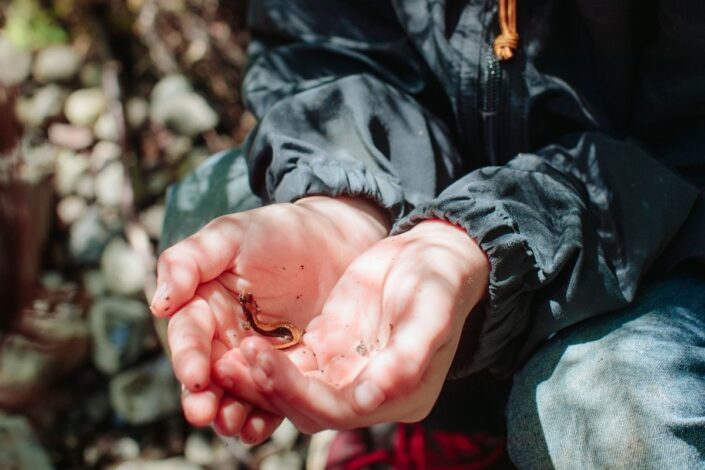Exploring Nature with Your Senses: Touch
While wandering through nature, we take in our surroundings using our senses. We smell flowers, touch tree bark, listen to bird calls, see details (like an ant trail on a tree), and even taste some of the natural objects we come across (think berries or edible flowers). And, while investigating nature in this way comes naturally to most children, sometimes we forget to allow children the time and space they need to do it.
We are sharing five different ways to explore each of the five senses with children. So get outside as a family, slow down, and explore nature with your senses together!
Photo Credit: Michelle Pearl Gee
Exploring Nature by Touch
Humans inevitably explore the world through touch. Pretty much every single moment of the day is filled with some variation of the touch sense. Though we take almost all of our touch sensations for granted and do not think much about them, one minute outside can feel like this: You touch the doorknob to let yourself outside and immediately feel the warm air and a slight breeze on your skin. You take a step outside and your bare feet feel the warm cement ground.
You walk toward your front yard and brush your arm up against a bush. You reach out to touch some flowers right before your feet touch the cooler grass. You take a moment to relish the feeling of the grass before you sit down and feel the soft ground under your body, and maybe a slight itchy feeling on your legs. The sensory experience of touch literally happens all the time, so much so we tend to block out much of what we are feeling. But, if we slow down outside, practice a little mindfulness, and think about each feeling as it touches our body, it can shift any outdoor experiences greatly.
Five ways to slow down and experience the sense of touch in nature:
- Create a touch box. Children love guessing games and creating this simple activity will not only provide a delightful family gaming experience but will also create an opportunity to really explore nature through touch. All you do is gather some simple nature items and put them inside a box. Don’t let your children see what is in the box and have them guess what nature item it is based on touch alone. You can put one item in at a time (good for younger children) or all at once to make it more challenging.
- Walk barefoot in nature. The human foot is incredibly sensitive and experiencing a variety of ground cover feels different on our feet and provides different sensory input. When you intentionally think about each sensation your feet are feeling, the whole experience of walking barefoot shifts just a bit.
- Find different textures in nature. Create a simple scavenger hunt and set your kids loose to find a variety of textures outside. You can also just have the ideas in your head and have the kids search for one at a time while you meander your favorite trail. Some examples of easy-to-find nature textures are rough, smooth, cold, warm, wet, dry, hard, soft, etc.
- Hug a tree. Literally. Not only will it feel really nice to do it, but you will also be able to feel different sensations. Are you able to wrap your hands all the way around? Is the bark rough or smooth?
- Count the skin sensations. Sit down for 1 to 5 minutes depending on the ages of your children and their ability to focus and count how many sensations you can feel on your skin. The wind on your skin, the warmth of the sun, the feeling of the ground under your body, the fly that landed on your leg, and so much more. It is hard to focus on only the feeling of touch, but it is amazing how many different things our skin can feel in just one minute.
Want to learn more about exploring nature with your senses? Check out our other posts on using your senses of hearing, taste, smell, and sight!
ABOUT OUTGROWN
OutGrown is a 501(c)(3) nonprofit that works to create a world where everyone can enjoy the physical and mental benefits of spending time outside. We are focused on creating opportunities and removing barriers to access so families with babies and young children can take their first steps outside. We believe all families have the right to connect with nature, benefit from spending time outdoors and be inspired to a lifelong love of nature. Since its grassroots inception in 2013, OutGrown is a growing community of 280,000 families and over 300 volunteer Branch Ambassadors. More information on all of our programs can be found at WeAreOutGrown.org
EDITORS NOTE:
We hope you enjoyed reading this article from OutGrown. We’re working hard to provide our community with content and resources that inform, inspire, and entertain you.
But content is not free. It’s built on the hard work and dedication of writers, editors, and volunteers. We make an investment in developing premium content to make it easier for families with young children to connect with nature and each other. We do not ask this lightly, but if you can, please make a contribution and help us extend our reach.
Related Content






Comments